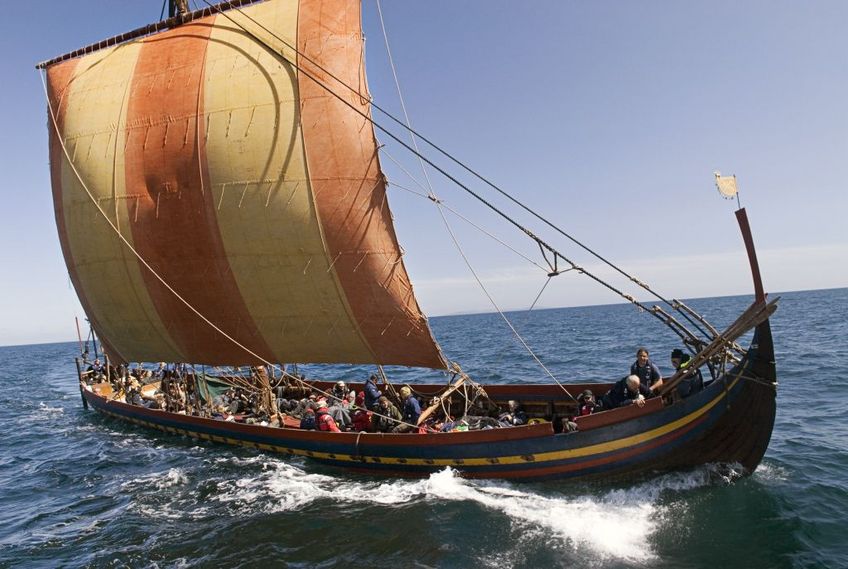The Viking longship is a testament to the ingenuity of ancient maritime engineering. Crafted from sturdy oak, ash or pine, the longship’s design was pivotal to the success of Viking navigators. The ship’s shallow draft allowed it to sail in waters just a meter deep, meaning it could navigate both the open sea and inland river systems. The symmetrical design also permitted the vessel to reverse course without needing to turn around, an invaluable feature when retreating from unexpected shore attacks or navigating tricky currents.

Sails and oars
Viking longships were primarily powered by a large, square sail, often emblazoned with bold patterns. In the absence of wind, oarsmen would propel the ships with considerable speed. The combination of sails and oars, along with the ship’s light weight, made the longship fast and agile – characteristics that were crucial for the voyages that took the Vikings across the treacherous North Atlantic and into the pages of history.
Impact on Viking Exploration
The exploratory missions of the Vikings were greatly enabled by the versatility of the longship. With the ability to cover vast distances, these vessels allowed the Norse people to reach the far-flung corners of the known world, from the Volga River in Russia to the shores of North America. The longship could carry significant cargo, enabling not just raiding parties but also traders and settlers to venture forth, bringing their culture, language, and economic influence with them.
Routes and discoveries
The Vikings used their longships to establish a variety of trade routes, some of which connected with the Silk Road, while others facilitated the exchange of goods between Iceland, Greenland, and the North American continent. Notably, these voyages of discovery were accomplished without the complex navigation tools that would come later, relying instead on landmarks, celestial bodies, and the legendary sunstone to find their way across uncharted waters.
Cultural exchange and expansion
The construction and deployment of the Viking longship were directly responsible for the Norse expansion that characterized the Viking Age. The expeditions launched from Scandinavia brought about cultural exchange and the spread of Norse influence throughout Europe and beyond. By establishing trade routes and settling in new territories, the Vikings left a lasting impact on the cultural and political landscapes of the medieval world.
Innovations in shipbuilding
The technical aspects of the longship, from its keel to its clinker-built hull (where planks were overlapped), influenced shipbuilding in cultures the Vikings came in contact with. The success of their longships spurred advancements in naval architecture across Europe, contributing to the development of the cog, a prominent merchant ship during the Middle Ages.
Legacy of exploration
The Viking longship was more than a vessel; it was a tool that shaped the course of history. Its design facilitated a mobile and far-reaching society, creating a legacy of exploration, trade, and conquest that is still admired today. The stories of Viking voyages have inspired countless generations with tales of adventure and discovery, and modern reconstructions of longships continue to teach us about the extraordinary capabilities of these ancient seafarers.
In conclusion, the Viking longship was a marvel of its time that played a crucial role in the explorations and achievements of the Viking Age. Its engineering allowed for flexibility in travel, and its use in exploration had an undeniable impact on the Vikings’ ability to reach distant lands, establish trade, and leave their mark on history.
1 thought on “The Viking Longship: Engineering and Impact on Exploration”